Having entered the war alongside the Allied Powers in August 1916, Romania would soon find itself in a dire predicament, fighting on two warfronts – both in Transylvania and along the Danube. Hence, as early as September 1916, the National Bank of Romania took the first steps to relocate its Treasure to a safe place.
Thus, the then-director of the NBR branch in Iași was instructed to meet director Theodor Căpitanovici at the train station “on Thursday, 8 September, at 5 p.m.”, to prepare several carriages and to book five hotel rooms. One week later, the mission of relocating the NBR Treasure to Iași was already completed. The Bank management’s special concern for this Treasure was attributable to the fact that it represented the legal metal reserve, the very basis for issuing banknotes. According to the NBR’s Statutes, “the Bank shall hold a gold reserve equal to at least 40 percent of the amount of notes it has issued”. In exceptional circumstances, as in times of war, the coverage decreased to 33 percent. Consequently, the volume of banknotes in circulation depended on the size of the metal reserve in the Treasure, as keeping the gold coverage in place ensured the convertibility of the domestic currency, i.e. the leu. Although the National Bank of Romania was a private bank from 1900 to 1925, the metal reserve did not belong to its shareholders, but to the Bank, it was “our wealth”, as the then-Governor I. G. Bibicescu used to say.
With the Central Powers’ troops closing in on Bucharest, the Royal Family, the Government, the Parliament and other central institutions of the Romanian state took refuge in Iași. As of 14 November 1916, the National Bank of Romania also relocated its headquarters to the same Moldavian city, which became the capital of national resistance. With winter setting in, two thirds of the country’s territory were under occupation, the Romanian army had pulled back and had to be restored, and a large part of the population was seeking refuge to the east of the country, facing not only the harsh winter, but also famine and diseases.
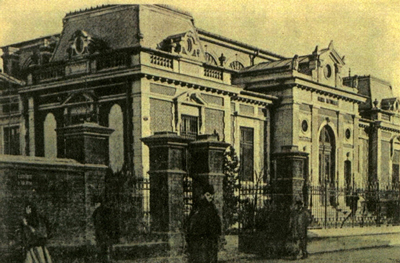
The NBR branch in Iași, which housed the NBR Treasure
from 8 September to 14 December 1916
(NBR Archives photo collection)
Under the circumstances, the Government and the NBR management decided to relocate the NBR Treasure to Russia, the only allied neighbouring country of the time. Romania’s Government and the NBR representatives signed with the Russian Empire’s representative in Iași the convention stipulating the terms and conditions of the first shipment to Moscow. According to it, the Romanian valuables were “under the Russian Government’s guarantee as regards the safety of shipment, the security of the deposit and the return to Romania”.
The first shipment took place in December 1916 and consisted of 1,738 cases of the NBR Treasure (1,735 with coins and three with bullions) and two cases containing Queen Maria’s jewellery. The NBR gold was worth lei 314.5 million, while the Queen’s jewels amounted to lei 7 million. The 1,740 cases were stored at the Kremlin, in the Armoury Chamber, in the section reserved for the Moscow branch of Russia’s State Bank, and were inventoried January through February, when it was certified that “actually, all valuables checked, either inventoried or weighed, proved to be – in terms of both quantity and value – in conformity with the National Bank of Romania’s statements”.
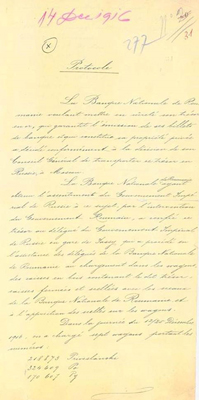
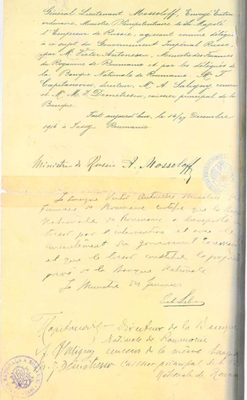
Protocol signed in Iași, on 14 December 1916,
by the Russian representative, A. Mossoloff, Victor Antonescu, Romania’s Minister of Finance,
and NBR representatives (Th. Căpitanovici, Anghel Saligny and M. Z. Demetrescu)
upon loading the NBR Treasure onto the train
(first and last pages, NBR Archives, Secretariat, file 5/1916).
In the summer of 1917, the Romanian authorities in Iași were expecting a massive military offensive by the Central Powers and, in such a tense environment, the second shipment to Moscow of Romania’s Treasure took place. This time, the train to the Russian capital included valuables belonging not only to the National Bank of Romania, but to other institutions as well (the Romanian Academy, the Deposits and Consignments Bank and other banks, the National Archives of Romania, the National Museum of Antiquities, the State Art Gallery, various ministries, monasteries). According to the protocol signed this time as well by the Russian representative, Romania’s Minister of Finance and NBR representatives, the three train carriages loaded with NBR valuables, which were housed in the same room at the Kremlin, consisted of “securities, valuables, deposits, parts of archives and books, documents, as well as the gold from the NBR’s metal deposits, the NBR’s private property”. The Romanian goods shipped to Moscow in July 1917 totalled lei 7.5 billion, with the NBR valuables in the three carriages evaluated at lei 1.5 billion, of which gold worth lei 575,000. As regards gold, in December 1916 and July 1917, the National Bank of Romania deposited a total of 91.48 tonnes of fine gold in Moscow.
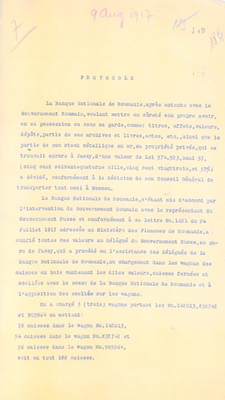
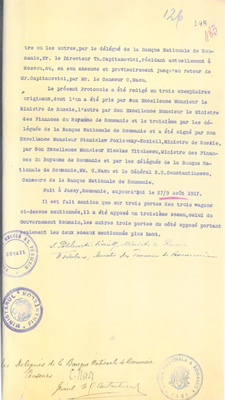
Protocol signed in Iași, on 27 July 1917, by S. Poklewsky Koziel, the Russian representative,
Nicolae Titulescu, Romania’s Minister of Finance, and NBR representatives
(C. Nacu and General N.C. Cantacuzino) for the second shipment of valuables to Moscow
(first and last pages, NBR Archives, Secretariat, file 5/1916)
In October 1917, the Bolsheviks led by V. I. Lenin seized power and, in January 1918, the Council of People’s Commissars announced the severance of diplomatic ties with Romania, the placing under arrest of Romania’s ambassador to Petrograd, and the seizure of Romania’s Treasure housed in Moscow, adding that “the Soviet power assumes the responsibility for safekeeping this Treasure in order to hand it over to the Romanian people”.
The seizure of the NBR Treasure dealt a heavy blow to Romania’s monetary balance, but – at least during the first years after the Great War – the hope of recovering it was still alive. In particular, in February 1920, the NBR Board stated that “we have information that allow us to hope the Treasure is still safe and sound, while the Allied Powers have renewed their promises to help us recover it”. Consequently, the NBR gold sent to Moscow continued to be mentioned in the Romanian central bank’s balance sheet as a “disputed claim on foreign parties” until 1929, when monetary stabilisation was carried out and the claim was extinguished altogether. Even afterwards, however, the Moscow gold was listed as a “pro memoria item” in the annual accounts up until 1943. With the Red Army settling in Romania, the NBR balance sheet no longer included any mention in this respect from 1944 onwards.
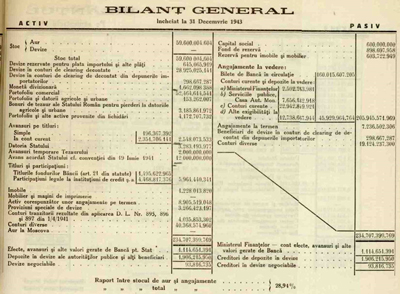
The general balance sheet of the National Bank of Romania
as of 31 December 1943 including the “Moscow gold” item
(Annual Report of the NBR Board, February 1944).
The thorny issue of the NBR Treasure marked the Romanian-Soviet and then the Romanian-Russian ties over the past century, because – despite the two partial restitutions of 1935 and 1956 respectively – the signs of goodwill never included the NBR gold stored in Moscow. That is why, in the words of Governor Mugur Isărescu, “neither the NBR, nor the Romanian Government – irrespective of its ideological leaning – abandoned the attempts to recover the Treasure of the National Bank of Romania”.
The talks leading to the signing of the Treaty on Friendly and Cooperation Relations between Romania and the Russian Federation on 4 July 2003 marked an opportunity to revisit the problem of Romania’s Treasure. The issue was mentioned in the joint statement by the two foreign ministers, who agreed to set up a joint commission to look into the outstanding problems in the history of bilateral relations, including that of Romania’s Treasure. In the period from 2003 to 2016, the Romanian-Russian Joint Commission convened four times. The National Bank of Romania, as the repository of the clearest evidence, was present at all four meetings of the Commission and submitted the original documents that testify to the handover of its Treasure to the representatives of the Russian state, a fact acknowledged by the Russian side. In 2016, 100 years since the departure of the first train to Moscow, “we, at the National Bank of Romania, still consider it our duty to take all necessary action for these valuable goods to return home”, Governor Mugur Isărescu said.